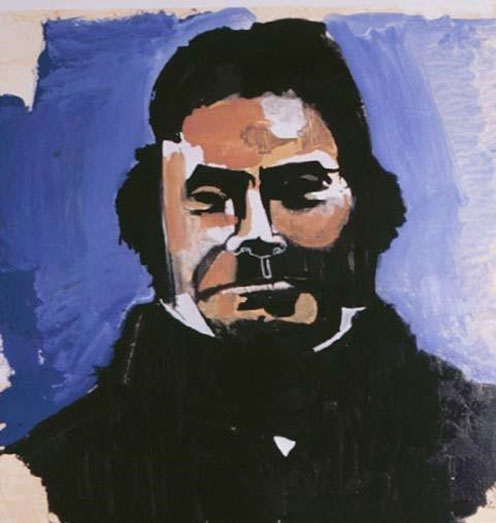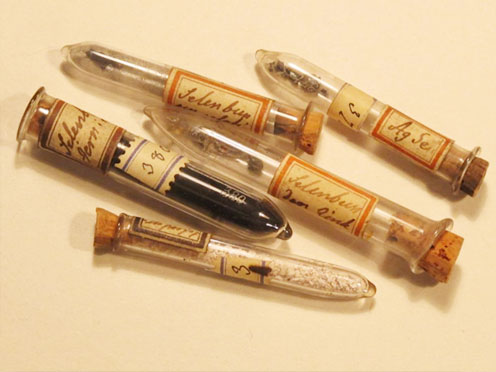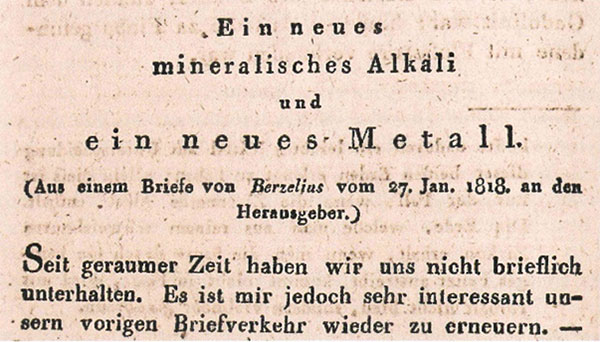The Discovery of Selenium by Jacob Berzelius
Jan Trofast, PhD, Lund, Sweden

Jacob Berzelius (1779-1848)
Painting by P.O. Finnström, 1979
Private. Photo: Jan Trofast
As partners the Gripsholm Chemical Factory was acquired by the chemists Jacob Berzelius, Hans Peter Eggertz and Johan Gottlieb Gahn (1745-1818, discoverer of manganese in 1774) in 1816. They met at Gripsholm in August 1817 in order to investigate the manufacturing processes. In connection with this work they made some preliminary investigations of the bottom sludge of the lead chambers used for sulfuric acid production. The former owner of the factory, M. Bjuggren, had noted that a reddish sludge occurred in the lead chamber, only when pyrite (an iron sulfide) from the mine in Falun was used. The sludge was believed to be an arsenic compound and hence the Falun pyrite was avoided. However, Gahn and Eggertz both came from Falun and considered it interesting and important to use Falun pyrite. Therefore, Gahn and Berzelius - being the experts - tried to analyze the reddish sludge. By roasting 200 kg of sulfur they obtained about 3 g of a precipitate. Their subsequent chemical analysis of the sample indicated the possible presence of tellurium. However, Berzelius doubted this result since tellurium had never been found in minerals from Falun. Nevertheless, he wrote about tellurium in letters to his close friends Alexandre Marcet and H.G. Trolle Wachtmeister in the fall of 1817.
In early 1818, Berzelius repeated the experiments in his Stockholm laboratory and concluded that the sludge must contain a new element. The new element had properties of a metal, and was similar to sulfur, initially suggesting it to be a new species of sulfur. In its metallic state, it had a brilliant grayish lustre. When heated by a candle using blowpipe analysis, it burned with an azure-blue flame and emitted a strong odor of horseradish, typical of tellurium. This smell may initially have fooled Berzelius and Gahn. Klaproth had assigned tellurium (Latin: tellus, earth) to F.J. Müller von Reichenstein’s new element in 1784. Berzelius chose the name selenium (Greek: selene, moon) for the new element, noting its resemblance to tellurium.

From Jac. Berzelius’s collection of selenium compounds
at Center for the History of Science,
Royal Swedish Academy of Science, Stockholm.
Photo: Jan Trofast
Berzelius’ first announced the new element in a letter of 27 January 1818 to J.S.C. Schweigger in Germany, followed by a letter in April for immediate publication in his Journal für Chemie und Physik, XXI (1817), 342-344. In February, he sent descriptions to scientific friends including C.L. Berthollet (published in Annales de Chimie et de Physique), A. Marcet (published in Annals of Philosophy), and H.G. Trolle Wachtmeister. The comprehensive investigation of the discovery of selenium was finalized in April 1818 and published in Afhandlingar i Fysik, Kemi och Mineralogi, VI, (1818), 42-144.

The first official announcement of the discovery of selenium from a letter of 27 January 1818
from Jac. Berzelius to J.S. Schweigger in Journal fur Chemie und Physik, XXI, (1817), 44-48.
The new alkali refers to lithium discovered by J.A. Arfwedson in the Berzelius laboratory.
Berzelius’s analysis had given 28.74 % oxygen in the compound consisting of one atom selenium and two atoms of oxygen – theoretically 28.84 %. Berzelius accepted the value of 79.3 (H=1) for the atomic mass of selenium. The value today is 78.96, which shows the remarkable accuracy of Berzelius’s chemical analysis. Eilhard Mitscherlich, pupil to Berzelius, also performed a number of experiments about the oxidation of selenium. Based on the results that the ratio of oxygen in the oxides is 2:3 forced Berzelius to change the names to the more correct name selenous acid (SeO2) and selenic acid (SeO3) - denoting the anhydrides.
The discovery of selenium led to an increased reputation for Jacob Berzelius as one of the leading chemists in the world. His creativity and capacity for observation, chemical intuition and knowledge created remarkable results.
Further Readings
Trofast, Jan. 2016. Discovery of Selenium. 47-67. In: Jan Trofast. Jac. Berzelius: The Discovery of Cerium, Selenium, Silicon, Zirconium and Thorium: A short Story. Lund: Ligatum AB.
Trofast, Jan. 2011. Berzelius’ Discovery of Selenium. Chemistry International, 33(5): 16-19.
